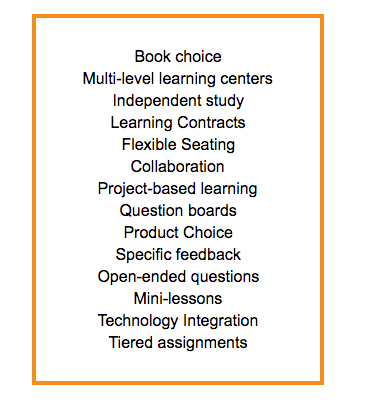
Differentiation is an idea as old as effective teaching.”
It is a student-focused way of thinking about teaching and learning, and it is designed to address learning and affective needs that all students have. (Carol Ann Tomlinson, author of How to Differentiate Instruction in Academically Diverse Classrooms.)
Students in our diverse classrooms have different backgrounds, interests, and strengths. They learn in different ways and want to know how learning is relevant to their lives. Differentiation enhances learning for all students.
The first step in a differentiated classroom is knowing the skill level of the students. Certain students may require extra help, whereas others already understand and can apply the skill. Math instruction in a third grade differentiated classroom might include a pre-assessment referred to as “Most Difficult First.” In this practice, students do the most difficult problems first. Students who demonstrate understanding of a concept can skip the instruction and proceed to more challenging concepts.
- Some students could be investigating the sums of different sequences of addends, such as consecutive odd or even numbers, in a small group.
- Other students could be independently exploring the same patterns on a deeper level, using algebraic expressions to explain their findings.
- Others might be creating their own mental math challenges for others to solve.
Teachers who modify the content, process, or product of the curriculum are using differentiation to respond to students’ instructional readiness, interests, and skill levels. They serve as facilitators to meet students at their starting points and move each student forward based on individual needs
Teachers Can Differentiate

According to Students'

The content is the topics/concepts/skills the students must learn. Relevant content matters to students and makes what is taught and learned much easier. One way to differentiate content is through acceleration of instruction. Students can work ahead independently.
Process is how students learn the content. Differentiate the process by modifying the pace, the complexity, or the activities. For example, directions can be specific for some students and more open-ended for others. Students might visit a classroom center for an in-depth study of a topic of interest.
Differentiating the product means varying the complexity of the product – the end result of what the students learned and are able to apply. There are numerous sources of product ideas for teachers. It is motivating for students to be offered a product choice that is personally relevant.
Tomlinson also uses the learning environment as a fourth way to differentiate. This includes the classroom’s operation and tone, such as furniture arrangement, lighting, and procedures.
Modify the Pace, Complexity, or Activities with Differentiation
 *You can check out some differentiated classroom resources by clicking these links: Book choice; Technology Integration.
*You can check out some differentiated classroom resources by clicking these links: Book choice; Technology Integration.
Tomlinson further explains how, in a classroom without differentiation, student similarities seem to take center stage. “In a differentiated classroom, commonalities are acknowledged and built upon, and students’ differences also become important elements in teaching and learning.” (How to Differentiate Instruction, 2017)
How are you using differentiation in your classroom?
